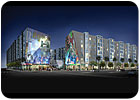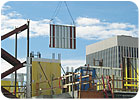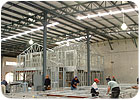
KHS&S Contractors and FrameMax share a passion to enhance the way buildings are framed and they are making their marks in Southern California.
"For decades, traditional steel framing has remained the same with no significant changes in techniques from bracing to bridging," says Kevin Greer, operations manager for the load bearing division of KHS&S, one of the nation's largest wall and ceiling contractors. "But with innovations in pre-fabrication technologies and composite materials, the building industry is exploding with new possibilities."
It was such innovation that brought KHS&S together with Phil Ellis, FrameMax founder and CEO. Ellis has invented a patented technology that automates production of pre-fabricated steel-framing materials for residential construction. Together, the two companies are bridging the gap between cost-focused design and high-quality housing.
A few years ago, Ellis invited KHS&S executives on a tour of his company's 100,000-square-foot fabrication facility in Tecate, Mexico. Greer and his colleagues were convinced FrameMax's facility could handle production of panels in the extremely tight tolerances the projects require.
At the time, KHS&S was breaking into a typically non-union residential market. According to Greer, the only way for KHS&S to keep its union workers on board was to realize economies with their materials.

Benefits of steel
"We are always looking for ways to control costs in the building process without sacrificing quality," says Greer. "Steel is a superior product but has often been considered too expensive to use, especially in the residential market."His clients receive preferred insurance rates by using steel because the material performs better in fire, earthquake and floods. Steel is also mold resistant and minimizes punch list and warranty call-backs for nail pops and cracks.
Eco-conscious builders and homebuyers are attracted to the green aspects of affordable building options. An average home with wood framing takes approximately one acre of trees to build. Some steel framing systems can reduce the use of wood by 90 percent and produce durable framing with an average of 65 percent recycled materials.
When the two companies teamed up, builders were beginning to tighten their belts as the industry began experiencing a decline in housing starts, a decrease in building permits and rising interest rates.
Ellis developed the technology 10 years ago in New Zealand when he came up with the idea while constructing his 5,000-square-foot home. The former computer programmer was newly retired and looking for ways to reduce the cost of wood framing for his house. Steel was an option but expensive due to the manufacturing and labor cost.
Ellis wrote a computer program that automated the framing manufacturing process and reduced the overall costs associated with steel framing materials.
The modular lightweight steel framing panels are produced through computerized design and an automated manufacturing process that renders a steel building material at an average of 20 percent savings over wood.
"One of the greatest benefits to computerized design and automated manufacturing is the 3-D model we can review with clients before construction begins," says Ellis. "We are able to look at every panel, cut through sections and make sure everything lines up the way the architect intended."
FrameMax's roll formers produce panels to specifications within a hundredth of an inch. The "snap-to" connection of the modular panels also cuts on-site framing labor costs by an average of 50 percent on projects, including one of the company's biggest undertakings to date.

Building big
One of KHS&S and FrameMax's ongoing joint ventures is a mixed-use, multi-family project in the Wilshire district of Los Angeles. The 453,000-square-foot, $100 million housing project involves 449 residential units and 65,000 square feet of retail and restaurant space.Urban Partners LLC hired the duo to fabricate and install all light-gauge steel panels for the development. KHS&S is also the primary subcontractor for interior drywall, finishes, and exterior wrap and plaster for the building.
The joint venture was assembled after initial designs were submitted to the City of Los Angeles permitting department and resulting changes sent the project's budget through the roof.
"We dug in our heels and pulled some creative value engineering to get the project back to an affordable range for the owner," says Ellis.
One important hurdle the team tackled is the region's seismic codes that limit the use of a light-gauge steel-only system to a structure of 65-feet high or lower. The Wilshire project is the tallest building in Southern California to be built with load-bearing light-gauge steel framing, standing six stories above one floor of concrete.
"This design pushed the limits of the system," says Greer.
CEMCO's Sure-Board sheet metal backed sheathing was used in addition to the metal stud wall panels to meet lateral strength requirements. The Sure-Board material is non-combustible, twice as strong as plywood and, in most cases, eliminates the need for structural steel.
Another common challenge in building multi-family, mixed-use structures is the laydown space around the projects, usually located in busy urban areas. This particular project resides at Los Angeles' Wilshire/Vermont Metro Red Line Station-a location that could not withstand excessive congestion from deliveries and site side assembly. To address this tight situation, FrameMax was able to ship the panels vertically, so trucks could leave trailers behind for the crane to hoist off the street and place directly into the structure.
Wilshire/Vermont project is nearing completion on time and within budget with a projected opening slated for August 2007.
KHS&S and FrameMax will next build nine dormitory buildings for California Polytechnic State University in San Luis Obispo. The structures comprise 800,000 square feet of load-bearing steel framing, housing 3,000 additional beds for students at the university. At completion, the project will be the largest student housing project to be built in the California university system.
"I don't think we've tapped into half of the possibilities that will ultimately settle how we typically frame buildings," says Greer.
If you read this article, please circle number 172.
Sidebar: FrameMax's Steel Framing System: How it Works
Step 1:Import architectural and structural CAD project plans directly into FrameMax's design software system.Step 2:The software produces engineering analysis and 3-D design model for all walls, floor joists and roof trusses in compliance with structural plans as outlined by the relevant building code, loadings, wind and seismic conditions, etc. This process, which is guided by the company's engineering team, ensures the framing has been accurately designed according to the plans.
Step 3:Utilizing the imported computerized files, the roll-forming machine automatically produces all component parts, accurately cut to length, punched and notched as required, and labeled for fabrication.
Step 4:All components are screwed into finished frames, and each frame is labeled for easy erecting on site. Add-on products such as door headers, hold-downs, shear bracing, etc., are installed. Product passes final quality control inspection.
Step 5:Fabricated frames are delivered to the job site for easy erecting by following simple layout plans provided from the design system.

Report Abusive Comment